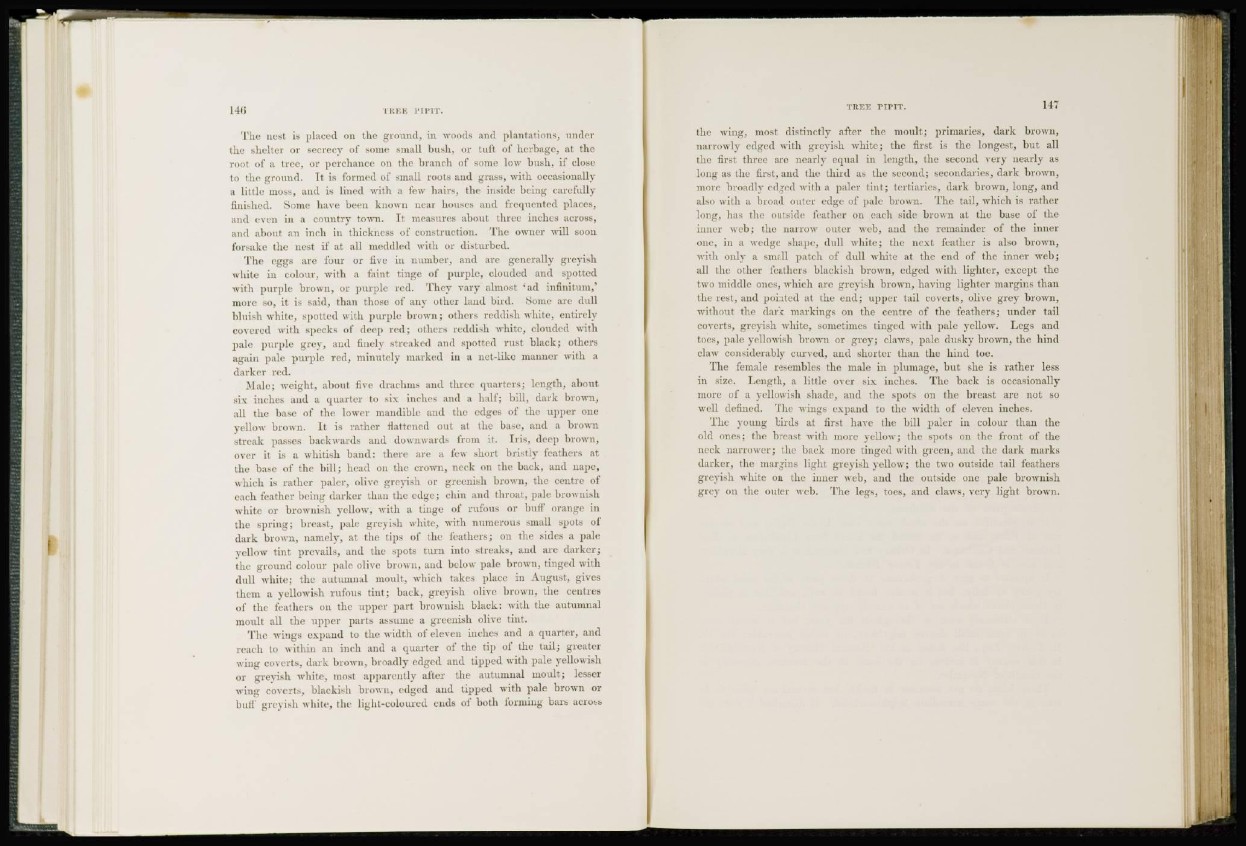
I 16 TREE PIPIT.
The nest is placed on the ground, in woods and plantations, under
the shelter or secrecy of some small bush, or tuft of herbage, at the
root of a tire, or perchance on the branch of some low bush, if close
to tin- ground. It is funned of small roots and grass, with occasionallv
a little moss, and is lined with a few hairs, the inside being carefully
finished. Some have been known near houses and frequented places,
and even in a country town. It measures about three inches across,
and about an inch in thickness of construction. The owner will soon
forsake the nest if at all meddled with or disturbed.
The eggs are four or five in number, and are generally grevish
white in colour, with a faint tinge of purple, clouded and s p o i l ed
with purple brown, or purple red. They vary almost 'ad infinitum,'
more so, it is said, than those of anv other land bird. Some are dull
bluish white, spotted with purple brown; others reddish white, entirely
covered with specks of deep red; others reddish white, clouded with
pale purple grey, and finely streaked and spotted rust black; others
again pale purple red, minutely marked in a net-like manner with a
darker red.
.Male; weight, about five drachms and three quarters; length, about
sis baches and a quarter to six inches and a half; bill, dark hi own,
all the base of the lower mandible and the edges of the upper one
yellow brown. It is rather flattened out at the base, and a brown
streak passes backwards and downwards from it. Iris, deep brown,
over it is a whitish hand: there are a few short bristly feathers at
the base of the bill; head on the crown, neck on the back, and nape,
which is rather paler, olive grevish or greenish brown, the centre of
each feather being darker than the edge; chin and throat, pale brownish
white or brownish yellow, with a tinge of rufous or buff orange in
the spring; breast, pale grevish white, with numerous small spots of
dark brown, namely, at the tips of the feathers; on the sides a pale
yellow tint, prevails, and the spots turn into streaks, and are darker;
the ground colour pale olive brown, and below pale brown, tinged with
dull white; the autumnal moult, wdiich takes place in August, gives
them a vellowish rufous tint; hack, greyish olive brown, the centres
of' the feathers on the upper part brownish black: with the autumnal
moult all the upper parts assume a greenish olive tint.
The wings expand to the width of eleven inches and a quarter, and
reach to within an inch and a quarter of the tip of the tail; greater
w bag coverts, dark brown, broadly edged and tipped with pale yellowish
or greyish white, most apparently after the autumnal moult; lesser
wing coverts, blackish brown, edged and tipped with pale brown or
buff greyish white, the light-coloured ends of both forming bars across
TREE PITTT. 117
the wing, most, distinctly after the moult; primaries, dark brown,
narrowly edged with greyish white; the first is the longest, but all
the first three are nearly equal in length, the second very nearly as
long as the first, and the third as the second; secondaries, dark brown,
more broadly edged with a paler tint; tertiaries, dark brown, long, and
also with a broad outer edge of pale brown. The tail, which is rather
long, has the outside feather on each side brown at the base of the
inner web; the narrow outer web, and the remainder of the inner
one, in a wedge shape, dull white; the next feather is also brown,
•with only a small patch of dull white at the end of the inner web;
all the other feathers blackish brown, edged with lighter, except the
two middle ones, which are greyish brown, having lighter margins than
the rest, and pointed at the end; upper tail coverts, olive grey brown,
without the dark markings on the centre of the feathers; under tail
coverts, greyish wdiite, sometimes tinged with pale yellow. Legs and
toes, pale yellowish brown or grey; claws, pale dusky brown, the hind
claw considerably curved, and shorter than the hind toe.
The female resembles the male in plumage, but. she is rather less
in size. Length, a little over six inches. The back is occasionally
more of a yellowish shade, and the spots on the breast are not so
well defined. The wings expand to the width of eleven inches.
The young birds at first have the bill paler in colour than the
old ones; the breast with more yellow; the spots on the front of the
neck narrower; the back more tinged with green, and the dark marks
darker, the margins light greyish yellow; the two outside tail feathers
greyish white on the inner web, and the outside one pale brownish
grey on the outer web. The legs, toes, and claws, very light brown.